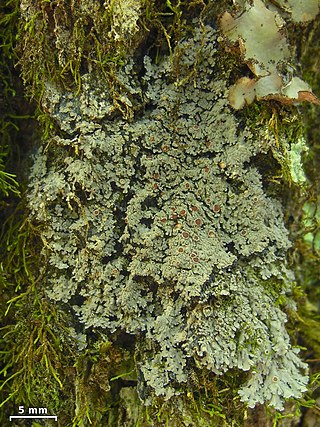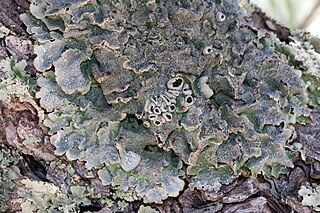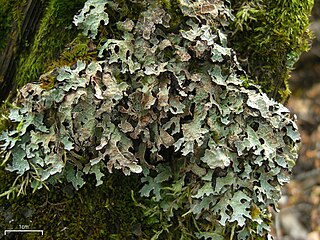
Fuscopannaria is a genus of lichen-forming fungi in the family Pannariaceae. It has 55 species.

Acarospora socialis is a usually bright yellow areolate to squamulose crustose lichen in the family Acarosporaceae that grows up to 10 cm wide, mostly on rock in western North America. It is among the most common lichens in the deserts of Arizona and southern California. It grows on sandstone, intrusive and extrusive igneous rock such as granitics, in all kinds of exposures to sunlight, including vertical rock walls. It is found in North America, including areas of the Mojave Desert and Sonoran Desert region, to Baja California Sur. It is the most common yellow member of its genus in southwestern North America. It sometimes, but rarely, grows on other soil crusts. It is a pioneer species.

Vahliella is a genus of nine species of lichenized fungi in the order Peltigerales. It is the only member of the Vahliellaceae, a family circumscribed in 2011 to contain this genus. Vahliella was formerly placed in the family Pannariaceae until molecular phylogenetics showed that it did not belong there. Vahliella species are found in the Northern Hemisphere – mainly in North America, but also in Europe and India.

Pyxine sorediata, commonly known as mustard lichen, is a widely distributed species of foliose lichen in the family Caliciaceae. It has a subtropical to warm temperate distribution, and grows on bark, rocks, and moss as substrates. Pyxine sorediata has been reported from regions of North America, Europe, Africa, Asia, and Australasia.
Melanohalea nilgirica is a species of foliose lichen in the family Parmeliaceae. Found in India, it was described as a new species in 2005 by lichenologists Pradeep Divakar and Dalip Kumar Upreti. The type was collected from the Nilgiri Hills in Tamil Nadu, at an elevation of 2,000 m (6,600 ft). Its thallus is about 6 cm (2.4 in) in diameter, with a reddish-brown to dark brown upper surface. It is characterized by flat, dot-like pseudocyphellae that are flush with the lobe surface, white capitate soralia, and presence of caperatic acid. This is the only known occurrence of this compound in the genus Melanohalea.

Punctelia hypoleucites, commonly known as the southwestern speckled shield lichen, is a species of foliose (leafy) lichen in the family Parmeliaceae. First formally described by Finnish botanist William Nylander as a species of Parmelia, it was transferred to the genus Punctelia in 1982. The lichen is found in Africa, North America, and South America, where it grows on the bark of both hardwood and coniferous trees. Its greenish-grey thallus is covered with tiny white pseudocyphellae – minute holes in the thallus surface that facilitate gas exchange. Some macroscopic features that help distinguish this species from other related members of the genus include the presence and the structure of the apothecia, the absence of asexual surface propagules, and the light brown color of the thallus undersurface. Chemically, the presence of lecanoric acid in the medulla and atranorin in the cortex help distinguish it from lookalikes.

Parmelia barrenoae is a species of foliose lichen in the large family Parmeliaceae. It was formally described as a new species in 2005. Before this, it was lumped together as one of several lichens in the Parmelia sulcata group—a species complex of genetically distinct lookalikes. Parmelia barrenoae is widely distributed, occurring in Europe, western North America, Africa, and Asia.
Steineropsis laceratula is a species of crustose placodioid lichen in the family Pannariaceae. It was first formally described in 1902 by French lichenologist Auguste-Marie Hue as Pannaria laceratula. Per Magnus Jørgensen proposed a transfer to Fuscopannaria in 1994. The taxon shuffled genera again in 2020 by Toby Spribille and Stefan Ekman after molecular phylogenetic analysis of the DNA from specimens collected in Alaska revealed its correct classification in the genus Steineropsis. The type specimen was collected in 1904 from Hakkoda, Japan, at an elevation of 1,200 m (3,900 ft); here the lichen was found growing on the bark of birch, but the species also grows on rock.
Arctomia teretiuscula is a rare species of squamulose (scaly) lichen in the family Arctomiaceae. It is found at high elevations in the mountains between Tibet and Sichuan, China.

Lepidocollema marianum is a species of cyanolichen in the family Pannariaceae. It was first scientifically described by Elias Fries in 1825 as Parmelia mariana. Per Magnus Jørgensen transferred it to the genus Lepidocollema in 2014 following a molecular phylogenetics-guided revision of the Pannariaceae.

Psora taurensis is a species of terricolous (ground-dwelling), squamulose lichen in the family Lecanoraceae. It is found in the Taurus Mountains of Turkey.
Fuscopannaria obtegens is a species of corticolous (bark-dwelling), squamulose lichen in the family Pannariaceae. Found in China, it was formally described as a new species in 2007 by Norwegian lichenologist Per Magnus Jørgensen. The type specimen was collected from Nyingchi-Dongjuk at an elevation of 4,430 m (14,530 ft); there, on a south-facing slope, it was found growing on the stems of Juniper. It is only known to occur in the type locality. The widely spread thallus of the lichen is made of dichotomously branched, brown squamules up to 2 mm (0.08 in) in diameter. The squamules are imbricating, meaning they overlap each other; according to the author, they give the impression of a tiled roof reminiscent of stave churches in Norway.
Fuscopannaria albomaculata is a species of squamulose (scaley), corticolous (bark-dwelling) lichen in the family Pannariaceae. Found in China, it was formally described as a new species in 2004 by Norwegian lichenologist Per Magnus Jørgensen. The type specimen was collected from Hailuogou Glacier Forest Park at an elevation between 2,940 and 3,130 m. The lichen grows on deciduous trees, especially birch and willow, in mountainous forests near glaciers, at elevations between 3,000 and 4,000 m. It is distinguished from other members of genus Fuscopannaria by the white spots on its thallus.
Fuscopannaria hirsuta is a species of squamulose (scaley), corticolous (bark-dwelling) lichen in the family Pannariaceae. Found in China, it was formally described as a new species in 2004 by Norwegian lichenologist Per Magnus Jørgensen. The type specimen was collected from the Nyenchen Tanglha Mountains in Tibet at an elevation of 2,500 m (8,200 ft), where it was found growing on Salix bark. It has also been recorded growing on Juniperus bark. The species epithet hirsuta refers to the hairy upper thallus surface, the first in genus Fuscopannaria with this characteristic.
Fuscopannaria granulifera is a species of squamulose (scaley), corticolous (bark-dwelling) lichen in the family Pannariaceae. Found in India, it was formally described as a new species in 2004 by Norwegian lichenologist Per Magnus Jørgensen. The type specimen was collected from the Great Himalayan National Park at an elevation of 3,140 m (10,300 ft). It is only known to occur in the upper forests of western Himalayas. F. granulifera is the only corticolous member of its genus that has a green algal photobiont; all others have a cyanobacterial photobiont.
Fuscopannaria dispersa is a species of corticolous (bark-dwelling), squamulose lichen in the family Pannariaceae. It is found in China, where it grows on the bark of several tree species at an elevation range from 3,650 to 4,300 m, close to the forest limit. It was formally described as a new species in 2000 by Norwegian lichenologist Per Magnus Jørgensen. The type specimen was collected by Joseph Rock from the eastern slopes of Likang Snow Range in 1922, and has since been documented in a few locations in eastern China. The lichen has a brown thallus made of small squamules spread out over a distinct black prothallus. Its ascospores are ellipsoid, colourless, lack septa, and measure 15–17 by 9–10 μm. Fuscopannaria dispersa is similar to the more widespread F. leucosticta, but can be distinguished from that species by the squamulose form of its thallus and by its smaller, rounder ascospores.
Fuscopannaria dissecta is a species of corticolous (bark-dwelling), squamulose lichen in the family Pannariaceae. Found in Japan, it was formally described as a new species in 2000 by Norwegian lichenologist Per Magnus Jørgensen. The type specimen was collected by Syo Kurokawa from Mount Kōya at an altitude of 800 m (2,600 ft); there it was found growing on the rotting bark of trees. The lichen has a pale brown thallus that forms irregular patches comprising squamules that about are about 2 mm wide. The squamules are dissected–cut deeply into fine lobes–and it is this character that is referenced in the species epithet dissecta.
Fuscopannaria rugosa is a species of corticolous (bark-dwelling), lichen in the family Pannariaceae. It is found in Hubei and Guanxi in China, where it grows in mountainous forests. Fuscopannaria rugosa is identifiable by its foliose-squamulose thallus, which has longitudinal wrinkles on the upper surface. It also has a distinct hypothallus, a relatively thick algal layer, and a cortex made up of thick-walled cells in both the thalline and apothecial structures. It produces simple, hyaline ascospores that have a smooth, pointed tip at their apex.
Fuscopannaria saltuensis is a species of ground-dwelling, squamulose lichen in the family Pannariaceae. It is found in both the Eastern and Western Himalayas, where it grows on soil in open mountain forests with pastures and cliffs.

Fuscopannaria leucosticta, commonly known as the rimmed shingle lichen, is a species of lichen in the family Pannariaceae. It has a squamulose (scaley) thallus that lacks soredia and isidia, but has abundant apothecia with distinct white rims. Although its main centres of distribution are eastern North America and southeast Asia, where it grows in damp forests, it has been reported from various other high-altitude, humid locations.








